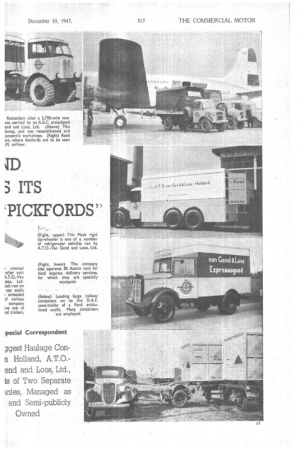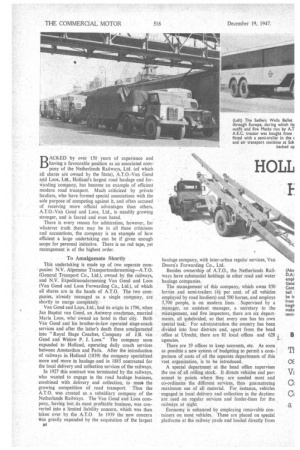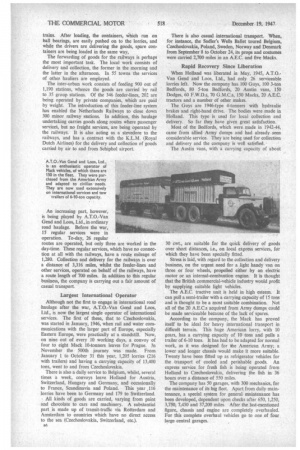3 ITS
Page 39

Page 38

Page 40

If you've noticed an error in this article please click here to report it so we can fix it.
.PICKFORDS' BACKED by over 150 years of experience and having a favourable position as an associated company of the Netherlands Railways, Ltd. (of which all shares are owned by the State), A.T.O.-Van Gend and Loos, Ltd., Holland's largest road haulage and forwarding company, has become an example of efficient modern road transport. Much criticized by private hauliers, who have formed special associations with the sole purpose of competing against it, and often accused of receiving more official advantages than others. A.T.O.-Van Gend and Loos, Ltd., is steadily growing stronger, and is feared and even hated.
There is every reason for admiration, however, for whatever truth there may be in all these criticisms and accusations, the company is an example of how efficient a large undertaking can be if given enough scope for personal initiative. There is no red tape, yet management is of the highest order.
To Amalgamate Shortly This undertaking is made up of two separate cornpanies: N.V. Algemene Transportonderneming—A.T.O. (General Transport Co., Ltd.), owned by the railways, and N.V. Expeditieonderneming Van Gend and Loos (Van Gend and Loos Forwarding Co., Ltd.), of which all shares are in the hands of A.T.O. The two companies, already managed as a single company, are shortly to merge completely.
Van Gend and Loos, Ltd.; had its origin in 1796, when Jan Baptist van Gend, an Antwerp coachman, married Maria Loos, who owned an hotel in that city. Both Van Gend and his brother-in-law operated stage-coach services and after the latter's death these amalgamated into "Royal Stage Coaches, Company of J.B. van Gend and Widow P. J. Loos." The company soon expanded to Holland, operating daily coach services between Amsterdam and Paris. After the introduction of railways in Holland (1839) the company specialized more and more in haulage and in 1885 contracted for the local delivery and collection services of the railways.
In 1927 this contract was terminated by the railways, who wanted to engage in the road haulage business, combined with delivery and collection, to meet the growing competition of road transport. Thus the A.T.O. was created as a subsidiary company of the Netherlands Railways. The Van Gend and Loos company, having lost its most profitable business, was converted into a limited liability concern, which was then taken over by the A.T.O. In 1939 the new concern Was greatly expanded by the acquisition of the largest s4 haulage company, with inter-urban regular services, Van Doom's Forwarding Co.,. Ltd.
Besides ownership of A.T.O., the Netherlands Railways have substantial holdings in other road and water haulage companies.
The management of this company, which owns 850 lorries and semi-trailers (44 per cent. of all vehicles employed by road hauliers) and 500 horses, and employs 5,700 people, is on modern lines. Supervised by a manager, an assistant manager, a secretary to the management, and five inspectors, there are six departments, all subdivided, so that every one has his own special task. For administration the country has been divided into four districts and, apart from the head office at Utrecht, there are 81 local offices and 628 ; agencies.
There are 19 offices to keep accounts, etc. As soon• as possible a new system of budgeting to permit a corn-1 parison of costs of all the separate departments of _this vast organization, is to be introduced.
A special department at the head office supervises the use of all rolling stock. It directs vehicles and personnel to points where they are needed most and co-ordinates the different services, thus guaranteeing maximum use of all material. For instance, vehicles engaged in local delivery and collection in the daytime are used on regular services and feeder-lines for the railways at night.
Economy is enhanced by employing removable containers on most vehicles. These are placed on special platforms at the railway yards and loaded directly from trains. After loading, the containers, Which run on ball bearings, are easily pushed on to the lorries, and while the drivers are delivering the goods, spare containers are being loaded in the same way, The forwarding of goods for the railways is perhaps the most important task. The local work consists of delivery and collection, the former in the morning and the latter in the afternoon. In 55 towns the services of other hauliers are employed.
The inter-urban work consists of feeding 900 out of 1,190 stations, whence the goods are carried by rail to 35 group stations. Of the 346 feeder-lines, 202 are being operated by private companies, which are paid by weight. The introduction of this feeder-line system has enabled the Netherlands Railways to close down 300 minor railway stations. In addition, this haulage undertaking carries goods along routes where passenger services, but no freight services, are being operated by the railways. It is also acting as a stevedore to the railways, and has a contract with the K.L.M. (Royal Dutch Airlines) for the delivery and collection of goods carried by air to and from Schiphol airport.
An increasing part, however, is being played by A.T.0.-Van Gend and Loos, Ltd., in ordinary road haulage. Before the war, 15 regular services were in operation. To-day, 26 regular routes are operated, but only three are worked in the day-time. These regular services, which have no connection at all with the railways, have a route mileage of 1,280. Collection and delivery for the railways is over a distance of 3,316 miles, whilst the feeder-lines and other services, operated on behalf of the railways, have a route length of 700 miles. In addition to this regular business, the company is carrying out a fair amount of casual transport.
Largest International Operator Although not the first to engage in international road haulage after the war, A.T.O.-Van Good and Loos, Ltd., is now the largest single operator of international services. The first of these, that to Czechoslovakia, was started in January, 1946, when rail and water communications with the larger part of Europe, especially Eastern Europe, were practically at a standstill. Now, on nine out of every 10 working days, a convoy of four to eight Mack 10-tonners leaves for Prague. In November the 500th journey was made. From January I to October 31 this year, 1,205 lorries (216 with trailers) and having a carrying capacity of 13,400 tons, went to and from Czechoslovakia.
There is also a daily service to Belgium, whilst, several times a week, convoys leave Holland for Austria, Switzerland, Hungary and Germany, and occasionally to France, Scandinavia and Poland. This year ,116 lorries have been to Germany and 179 to Switzerland.
All kinds of goods are carried, varying from paint and chocolate to cars and machinery. A substantial part is made up of transit-traffic via Rotterdam and Amsterdam to countries which have no direct access to the sea (Czechoslovakia, Switzerland, etc.). There is also casual international transport. When, for instance, the Sadler's Wells Ballet toured Belgium, Czechoslovakia, Poland, Sweden, Norway and Denmark from September 8 to October 24, its props and costumes were carried 2,700 miles in an A.E.C. and five Macks.
Rapid Recovery Since Liberation
When Holland was liberated in May, 1945, A.T.O.Van Gend and Loos, Ltd., had only 26 serviceable lorries left. Now the company has 100 Guys, 100 3-ton Bedfords, 80 5-ton Bedfords, 20 Austin vans, 150 Dodges, 60 F.W.D.s, 70 G.M.C.s, 150 Macks, 20 A.E.C. tractors and a number of other makes.
The Guys are 1946-type 4-tonners with hydraulic brakes and right-hand drive. The bodies were made in Holland. This type is used for local collection and delivery. So far they have given great satisfaction.
Most of the Bedfords, which were made in 1942-44, came from allied Army dumps and had already seen considerable service. They are being used for collection and delivery and the company is well satisfied.
The Austin vans, with a carrying capacity of about 30 cwt., are suitable for the quick delivery of goads over short distances, i.e., on local express services, for which they have been specially fitted.
Stress is laid, with regard to the collection and delivery business, on the urgent need for a light handy van on three or four wheels, propelled either by an electric motor or an internal-combustion engine. It is thought that the British commercial-vehicle industry would profit by supplying suitable light vehicles.
The A.E.C. tractive unit is held in high esteem. It can pull a semi-trailer with a carrying capacity of 15 tons and is thought to be a most suitable combination. Not all of the 20 A.E.C.s acquired from Army dumps could be made serviceable because of the lack of spares.
According to the company, the Mack has proved itself to be ideal for heavy international transport in difficult terrain. This huge American lorry, with 10 gears, has a carrying capacity of 10 tons and pulls a trailer of 6-10 tons. It has had to be adapted for normal work, as it was designed for the American Army; a lower and longer chassis would make it more suitable. Twenty have been fitted up as refrigerator vehicles for the transport of cooled and perishable goods. An express service for fresh fish is being operated from Holland to Czechoslovakia, delivering the fish in 36 hours over a distance of 550 miles.
The company has 50 garages, with 300 mechanics, for the maintenance of its big fleet. Apart from daily maintenance, a special system for general maintenance has been developed, dependent upon checks after 650, 1,250, 3,750, 7,450 and 37,200 miles. After the last-mentioned figure, chassis and engine are completely overhauled. For this complete overhaul vehicles go to one of four large central garages.












































































